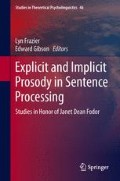Access this chapter
Tax calculation will be finalised at checkout
Purchases are for personal use only
References
Aylett, M., & Turk, A. (2004). The smooth signal redundancy hypothesis: A functional explanation for relationships between redundancy, prosodic prominence, and duration in spontaneous speech. Language and Speech, 47(1), 31–56.
Bader, M. (1998). Prosodic influences on reading syntactically ambiguous sentences. In J. D. Fodor & F. Fereirra (Eds.), Reanalysis in sentence processing (pp. 1–46). Dordrecht: Kluwer.
Cuetos, F., & Mitchell, D. (1988). “Cross linguistic differences in parsing” restrictions on the use of the late closure strategy in Spanish. Cognition, 3, 73–105.
Cutler, A., & Fodor, J. A. (1979). Semantic focus and sentence comprehension. Cognition, 7, 49–59.
Drenhaus, H., Zimmermann, M., & Vasishth, S. (2010). Exhaustiveness effects in clefts are not truth-functional. Journal of Neurolinguistics, 24(3), 320–337.
Fodor, J. D. (2002). Prosodic disambiguation in silent reading. In M. Hirotani (Ed.), Proceedings of the North East Linguistic Society 32. GSLA, University of Massachusetts, Amherst.
Jaeger, T. F. (2010). Redundancy and reduction: Speakers manage syntactic information density. Cognitive Psychology, 61(1), 23–62.
Lehiste, I. (1973). Phonetic disambiguation of syntactic ambiguity. Glossa, 7, 102–122.
Levy, R. P., & Jaeger, T. F. (2006). Speakers optimize information density through syntactic reduction. Proceedings of the 20th conference on neural information processing systems (NIPS) (pp. 849–856).
Liberman, M., & Prince, A. (1977). On stress and linguistic rhythm. Linguistic Inquiry, 8, 249–336.
Nespor, M., & Vogel, I. (1986). Prosodic structure above the word. In A. Cutler & R. Ladd (Eds.), Prosody: Models and measurements (pp. 123–140). Berlin: Springer-Verlag.
Rooth, M. (1992). A theory of focus interpretation. Natural Language Semantics, 1, 75–116.
Schafer, A., Carter, J., Clifton, C., Jr., & Frazier, L. (1996). Focus in relative clause construal. Language and Cognitive Processes, 11, 135–163.
Selkirk, E. O. (2011). The syntax-phonology interface. In J. Goldsmith, J. Riggle, & A. Yu (Eds.), The handbook of phonological theory (2nd ed.). Oxford: Blackwell.
Swets, B., Demset, T., Hambrick, D., & Ferreira, F. (2007). The role of working memory in syntactic ambiguity resolution: A psychometric approach. Journal of Experimental Psychology: General, 136(1), 64–81.
Wasow, T., Jaeger, T. F., & Orr, D. (2011). Lexical variation in relativizer frequency. In H. Simon & H. Wiese (Eds.), Proceedings of the 2005 DGfS workshop “Expecting the unexpected: Exceptions in Grammar” (pp. 175–195). Berlin: De Gruyter Mouton.
Author information
Authors and Affiliations
Corresponding author
Editor information
Editors and Affiliations
Rights and permissions
Copyright information
© 2015 Springer International Publishing Switzerland
About this chapter
Cite this chapter
Frazier, L., Gibson, E. (2015). Introduction. In: Frazier, L., Gibson, E. (eds) Explicit and Implicit Prosody in Sentence Processing. Studies in Theoretical Psycholinguistics, vol 46. Springer, Cham. https://doi.org/10.1007/978-3-319-12961-7_1
Download citation
DOI: https://doi.org/10.1007/978-3-319-12961-7_1
Published:
Publisher Name: Springer, Cham
Print ISBN: 978-3-319-12960-0
Online ISBN: 978-3-319-12961-7
eBook Packages: Humanities, Social Sciences and LawSocial Sciences (R0)

